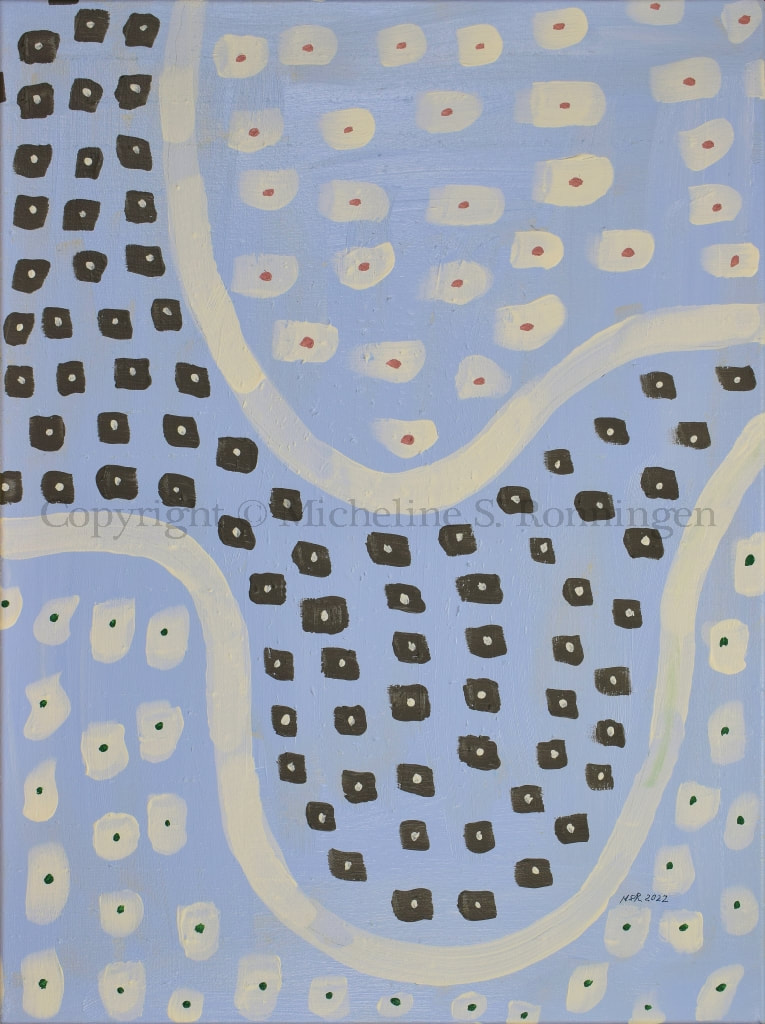Currently scientists have come up with a replacement for kingdoms and now recognize three domains: Bacteria, Archaea, and Eukarya. The fact that some life uses oxygen and some doesn’t can be a qualifying trait. My Three Domains is a 24 x 18 inch canvas using acrylic paint. It highlights that all life is connected, essential and unique. I may have to return to this topic.
Western science has been fudging and finessing categorizing life since the 1700s. Times were simple then: life was either plants or animals. Then things got complicated. Microorganisms lived and died! And which exact form, cell or group came first is actively debated.
The standard 6-kingdom system employed Eubacteria, Archae, Protista, Fungi, Plantae, and Animalia. The domain system now in use uses just three categories, as represented in my artwork: Bacteria, Archaea and Eukarya. Organisms are identified by characteristics on a molecular scale.
A BACTERIA cell doesn’t have a nucleus but has thick, rigid cell walls due to the presence of peptidoglycan. ARCHAEA cells don’t have a nucleus either, yet their cell walls are thin and soft, and contain lipids not found in any other organism. Archaea cells obviously do not contain peptidoglycan.
EUKARYA cells are the only life forms to possess a nucleus. Cell wall structure may be of cellulose, chitin, or chloroplasts since Eukarya covers the rest of the 6-Kingdom system: “Protista,” Fungi, Plantae, and Animalia.
Most of us can translate these Eukarya subgroups to fungi, plants and animals. But “Protista”
is composed of organisms “that are unicellular and sometimes colonial or less often multicellular and that typically include the protozoans, most algae, and often some fungi (such as slime molds).” https://www.merriam-webster.com/dictionary/protist . Most decidedly it is a blanket label for anything that doesn’t quite fit as a fungus, plant, or animal but might share some qualities with such. “Protista” descends from five different genetic lines.
Now that the live organism domains are clear, let’s turn to the all-important Life Cycle: origin, living, and death. We are all generally familiar with how people are born, live and die. Farmers, gardeners, chicken farmers, and ranchers pretty much know the cycles of their crops. Scientists, doctors and dentists are familiar with the habits of their targets. And most of us are aware of some products to deal with organisms or situations we don’t find helpful: antibacterial, antifungal, household cleaners, and garden pesticides. The Northern New England poison control center (https://www.nnepc.org/poison-information) lists hundreds of ways to be killed or to kill things. So we are aware of, and addressing, some life cycles, the ones we find useful and the ones we find especially irritating, inconvenient or unhealthy.
Death itself is just emerging from being a taboo topic for discussion. It’s receiving more public notice. People and pets passed away, were gone, or somehow never died. And cause of human death was a closed family matter. Yet death has long been a concern for religious and cultural purposes. Maybe that’s a topic for next time.
Note: there will be another Death Series for 2022, similar to last year’s tributes to significant people who died during the calendar year. If you want to nominate anyone for tribute, let me know. Email: [email protected].

